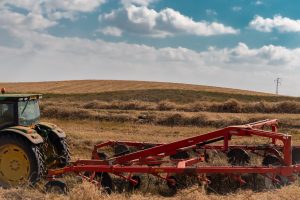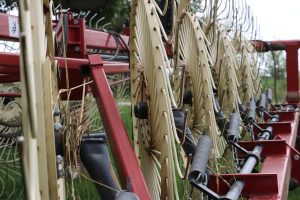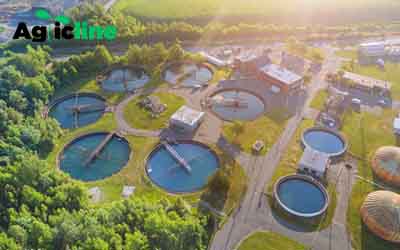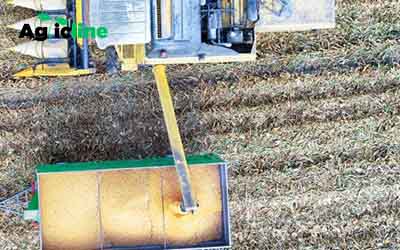The knowledge about the hay making equipment remains of utmost importance since hays are one of the prominent considerations when planning to start a farm.
Haymaking is the process of harvesting and storing grass or other forage crops for animal feed. It’s an important activity in agriculture, especially in areas where livestock is raised.
It’s important to note that haymaking practices can vary depending on factors such as climate, local traditions, and available equipment. Farmers may also choose to use hay preservatives or additives to enhance the quality and longevity of the hay.
In this blog post, I bring to you the different hay making equipment of popular demand and need. But before the, let’s take a look at the haymaking processes everyone ought to know.
Haymaking processes
See below;
Cutting
The first step in haymaking is cutting the grass or forage crop. This can be done using various methods, such as a scythe, sickle, or modern machinery like a mower or haybine. The crop is typically cut when it has reached the desired maturity for optimum nutrient content.
Drying
After cutting, the grass is left in the field to dry. This process is known as curing or wilting.
The grass is spread out in rows or windrows to expose a larger surface area to the sun and air, which helps remove moisture. Drying time depends on weather conditions and the type of forage being harvested.
Raking
Once the grass is sufficiently dried, it needs to be raked into rows or windrows to facilitate the next steps. Rakes, either manual or mechanical, are used to gather the cut grass into evenly shaped rows.
Baling
After raking, the hay is ready to be baled. Baling compresses the dried forage into tightly packed bales for storage and transportation.
There are different types of balers, including round balers and square balers. Round balers create cylindrical bales, while square balers produce rectangular bales.
Storing
The bales are stored in a suitable location to protect them from moisture and maintain their nutritional quality.
Hay is often stacked in barns, sheds, or covered storage areas to prevent exposure to rain or excessive sunlight. Proper storage helps prevent spoilage and preserves the hay’s value as animal feed.
Benefits of hay making in the farm
Haymaking offers several benefits to farms and livestock operations as describe below;
- Hay serves as a vital source of nutrition for livestock during times when fresh pasture or forage is scarce, such as in the winter or during dry spells. By making hay, farmers can ensure a consistent and adequate food supply for their animals throughout the year.
- Properly made hay retains much of the nutritional value of the original forage crop. It contains carbohydrates, proteins, minerals, and vitamins necessary for livestock growth, milk production, and overall development.
- Making hay allows farmers to preserve excess forage that would otherwise go to waste. By harvesting and drying the forage, they can store it for future use. This is particularly beneficial in regions with seasonal variations in pasture availability or unpredictable weather patterns.
- Hay provides flexibility in feeding schedules and methods. Farmers can adjust the amount of hay they provide to their animals based on their nutritional requirements, growth stages, and environmental conditions. It can be supplemented with other feeds or concentrates to meet specific dietary needs.
- By making hay, farmers reduce their reliance on purchased animal feeds, which can be expensive. Producing their own hay allows them to save on feed costs, especially during periods when commercial feed prices are high.
- Haymaking provides a form of risk management for farmers. It acts as a buffer against unpredictable weather events, such as droughts or excessive rainfall, which can negatively impact pasture growth.
- Regular haymaking practices, such as cutting and removing the forage, can help manage weed populations and promote healthier pastures. Cutting the grass at specific stages of growth helps control weeds by preventing them from producing seeds.
Challenges of hay makers face
While haymaking offers many benefits, there are also some potential disadvantages that farmers may encounter which is why the knowledge of effective hay making equipment remains of the utmost importance.
- The haymaking process is highly dependent on weather conditions. It requires dry weather for cutting, drying, and baling the hay. If the weather is unfavorable, such as prolonged rain or high humidity, it can delay the haymaking process, leading to reduced hay quality or even spoilage. Unpredictable weather patterns can make it challenging to time haymaking operations effectively.
- Haymaking can be labor-intensive, especially for smaller farms or operations without access to advanced machinery. It involves multiple stages, including cutting, drying, raking, and baling, which require manual labor or the use of specialized equipment.
- Storing large quantities of hay requires adequate space, whether it’s in barns, sheds, or covered storage areas. This can be a challenge for farms with limited infrastructure or smaller land sizes. Additionally, constructing or maintaining storage facilities can add to the overall costs of haymaking.
- Hay storage facilities can attract pests such as rodents, insects, or mold. If proper precautions are not taken, these pests can damage the stored hay and reduce its quality.
- Haymaking can have some environmental implications. Harvesting large amounts of forage from fields can impact soil health and nutrient cycling if not managed properly.

20 Hay making equipment you must know
Since you have learnt about the challenges faced by hay makers, it is important to note that some of the hay making equipment that are used in curbing these challenges and making hay making process as seamless as possible.
It is equally essential to note that the scale of agriculture will determine the type of equipment the hay makers would be needing their activities.
Let’s go.
- Mower: A mower is used to cut the standing grass or forage crop. It can be a sickle bar mower, drum mower, or disc mower, which is attached to a tractor or operated as a standalone machine. Mowers are available in different sizes and configurations to match the scale of the operation and the type of terrain.
- Tedder: A tedder is used to spread and fluff the cut hay after it has wilted. It consists of rotating tines or forks that lift and aerate the hay, allowing for faster and more even drying. Tedding helps expose more surface area of the hay to sunlight and airflow, promoting the drying process.
- Rake: A rake is used to gather the hay into rows or windrows for baling. There are various types of rakes, including wheel rakes, rotary rakes, and parallel bar rakes. They gather the hay into uniform rows, making it easier for subsequent baling or further drying.
- Baler: A baler is used to compress and bind the dried hay into bales for storage and transportation. There are different types of balers, including round balers and square balers. Round balers produce cylindrical bales, while square balers create rectangular bales. Balers may be operated manually, pulled by a tractor, or self-propelled.
- Haybine/Mower-Conditioner: A haybine or mower-conditioner is a combined machine that both cuts the hay and conditions it for drying. It consists of a cutting mechanism and conditioning rolls or flails that crimp or crush the hay stems, helping to speed up the drying process by exposing more surface area.
- Bale Wrapper: A bale wrapper is used to apply plastic film or wrap around round bales to create silage bales. This equipment is commonly used for making haylage or silage, where the baled forage undergoes a fermentation process inside the wrapped bale, preserving its moisture and nutritional content.
- Hay Rake/Tedder Combination: Some machines combine both raking and tedding functions in a single unit. These combination machines can save time and reduce the number of passes required in the field. They often have adjustable settings to switch between tedding and raking modes.
- Hay Moisture Tester: A hay moisture tester is a handheld device used to measure the moisture content of the hay. It helps determine if the hay has reached the optimal moisture level for baling and storage. Monitoring moisture levels is crucial to prevent spoilage, mold growth, and nutrient loss.
- Hay Preservative Applicator: Hay preservative applicators are used to apply preservative products to hay during baling. These preservatives help inhibit mold growth and maintain the nutritional quality of the hay during storage. The applicators are typically attached to the baler and distribute the preservative onto the hay as it is being baled.
- Hay Storage Equipment: This includes equipment such as hay barns, sheds, or covered storage areas that provide protection from weather elements and help maintain the quality of stored hay. It may include features like ventilation systems, moisture barriers, and proper stacking methods to maximize storage capacity and minimize spoilage.
- Hay Accumulator: A hay accumulator is a device attached to a baler that collects and stacks small square bales as they are ejected. It eliminates the need for manual handling and stacking of individual bales, saving time and labor during the baling process.
- Hay Grapple: A hay grapple is a hydraulic attachment for loaders or skid steer machines used to handle and transport large round bales. It consists of arms or tines that grip the bale securely, allowing for efficient loading, unloading, and stacking of bales.
- Hay Elevator: A hay elevator, also known as a bale elevator, is a conveyor system that lifts and moves bales vertically. It is often used to transport bales from ground level to upper-level storage areas, such as haylofts or elevated feeding areas. Hay elevators can be powered by electricity or attached to tractors through a power take-off (PTO) system.
- Hay Squeeze: A hay squeeze, also called a bale squeeze or bale handler, is a hydraulic attachment for loaders or forklifts used to handle and transport large square or round bales. It features two arms that grip the sides of the bale, allowing for easy and secure lifting, stacking, and transport.
- Hay Preservative Applicator System: In addition to the hay preservative applicator mentioned earlier, some larger operations use integrated hay preservative applicator systems. These systems include tanks, pumps, and distribution systems that automatically mix and apply preservatives to hay during the baling process.
- Hay Moisture Monitoring Systems: These systems consist of sensors or probes that are installed in balers or bale accumulators to continuously monitor the moisture levels of baled hay. They provide real-time data on hay moisture, enabling farmers to make adjustments during baling or to identify potential spoilage issues.
- Hay Mergers: Hay mergers, also known as merger pickups or windrow mergers, are specialized machines that combine multiple windrows of hay into a single, wider windrow. They are particularly useful when multiple passes of mowing or tedding have been done, and the hay needs to be consolidated for efficient raking and baling.
- Hay Bale Unroller: A hay bale unroller is a piece of equipment used to unroll round bales or large square bales. It is commonly used in feeding systems where bales are unrolled directly on the ground or in feed alleys, allowing animals to access the forage more easily.
- Hay Grinder/Processor: A hay grinder or processor is used to process hay bales into finer particles or chaff. It can be used for mixing hay with other feed ingredients or for improving the digestibility of forage. Processed hay can be more palatable for livestock and may be suitable for specific feeding systems.
- Hay Moisture Probe: A hay moisture probe is a handheld device used to directly measure the moisture content of individual bales or hay stacks. It is inserted into the hay and provides instant moisture readings, allowing farmers to assess the quality and suitability of the hay for storage or feeding.

A final thought about hay making equipment
Haymaking equipment plays a crucial role in the efficiency and success of the haymaking process. Whether it’s the cutting, drying, raking, baling, or handling of hay, the right equipment can save time, reduce labor, and help maintain the quality of the forage.
Investing in reliable and appropriate haymaking equipment can significantly impact a farmer’s productivity and profitability. Modern machinery and attachments offer enhanced efficiency, precision, and convenience, allowing farmers to maximize their hay production while minimizing losses and maintaining nutritional value.
However, it’s important to select equipment that matches the specific needs, scale, and resources of the farm. Consider factors such as field size, topography, available labor, budget, and the type of forage being harvested.
Proper maintenance and regular inspections are also essential to ensure the equipment remains in good working condition, minimizing downtime and maximizing its lifespan.



